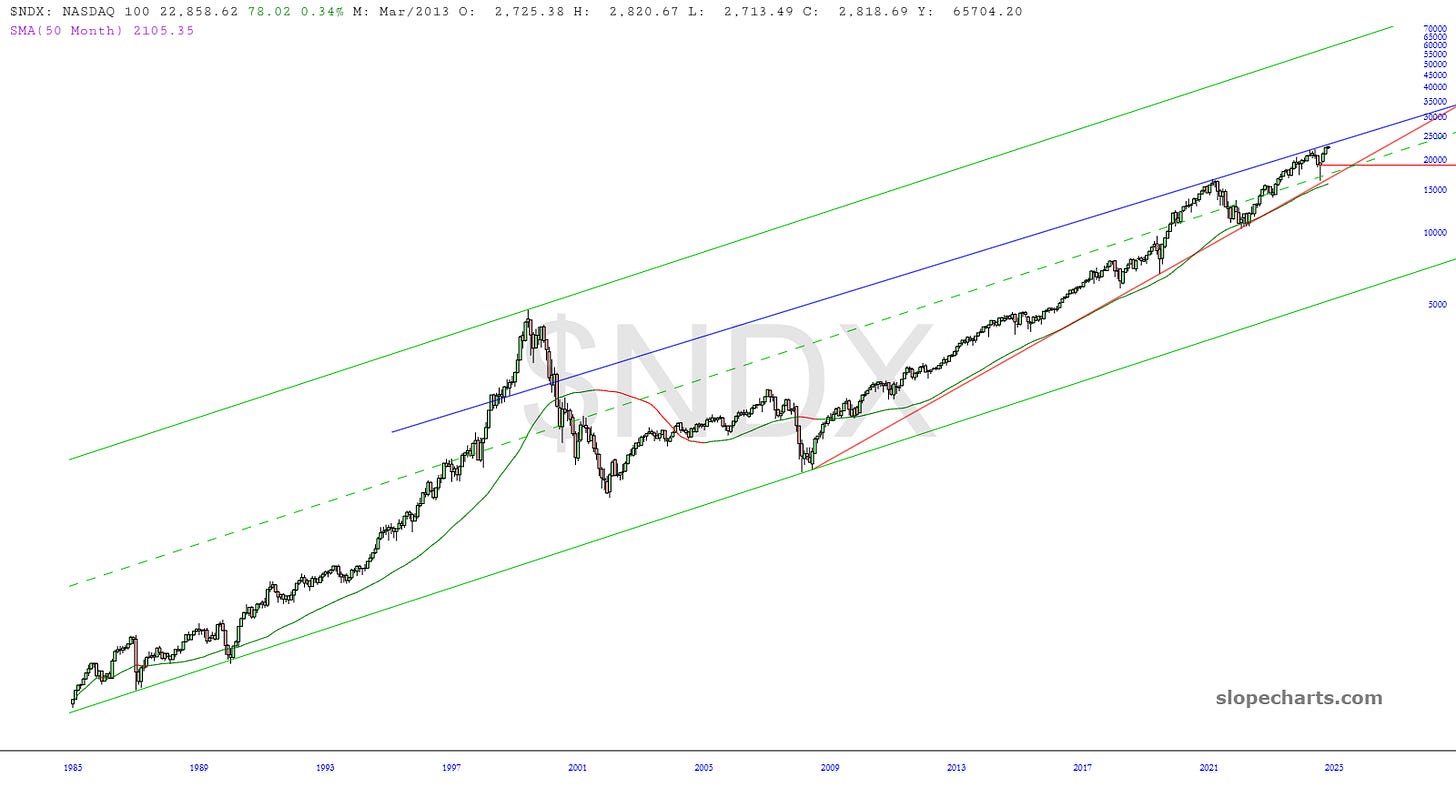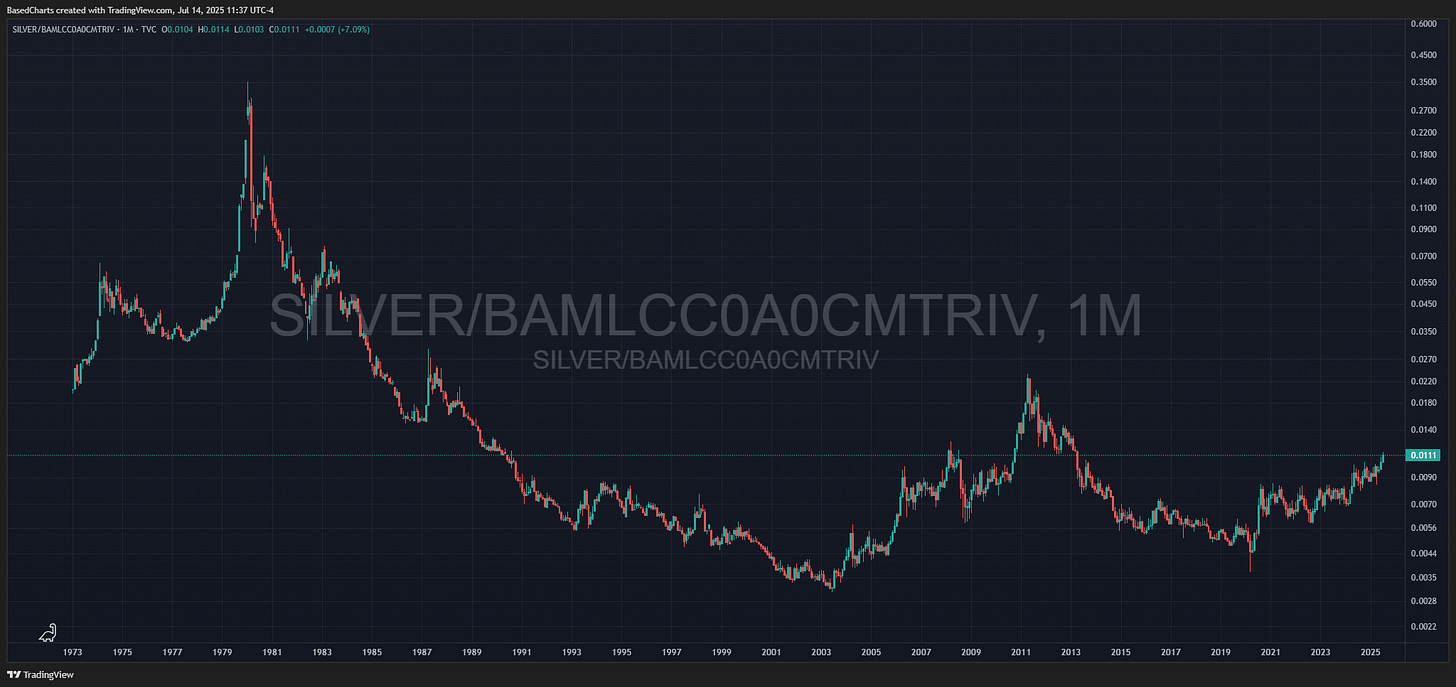Navigating a Crack-Up
AGMR has now just about tripled. This is still a cheap stock, but it was a likely 10x when I mentioned it a week before takeoff, near 60 cents in Canada. I didn’t expect it would run like this. In a crack-up scenario it will likely, along with other resource stocks, keep running. This could be a CAD$10 stock if silver is headed to $50 or higher.
There are many charts that look like some variation of this. Most didn’t move as quickly, but there are two points about the setup that apply across the market.
First, undervalued companies. Investor attention is on Nasdaq, Nvidia, YOLO stocks, the “Trump” complex which is what I’d dub the rare earths, uranium, nuclear, etc. plays that are dependent on political moves. There’s a lot of value in the “Trump” plays (it’s not a purely Trump story, but he’s the shiny object in the news for now), but also some stocks getting ahead of themselves or outright overvalued. However, lots of foreign stocks and commodity-related businesses are trading at deep discounts to the major U.S. indexes.
Two, the timing is unknown. These stocks can trade at depressed prices for years on end. They could start rallying slowly or some event could trigger what is commonly referred to as a “re-rate” in the mining sector. As if a switch is flipped, investors suddenly decide to value the asset differently.
In conclusion, it’s best to accumulate these stocks in their cheap, flatline phase. If you’re not a money manager being judged by quarterly results, you can manage money with an eye towards long-term gains. A 10x return over a decade equates to 26 percent annualized returns. Have positions on lots of companies with big based charts and then aggressively buy the breakouts.
Some of the bases aren’t impressive, like China small caps versus SPY. A return to the ratio high though, if SPY remains up around $600 in the coming decade, would argue for a 6x in ECNS. In order for ECNS to do a 6x, one should be able to throw a dart and find Chinese small-caps with 10x potential.
Don’t like China? Fine. There are dozens of emerging markets out there. Developed markets. Commodities. How about fertilizer? MOS looks like a higher low on a relative double-bottom.
Can Tech Keep Running?
Unless we’re headed into a new digital economy which is the “New Economy” theory of the late 1990s, U.S. equities are stretched relative to commodities. To enter a digital economy, one must assume the money only goes one way. A new digital economy grows with no feedback. Not to be derisive, but to explicate via exaggeration: it has to become an Otaku economy where people would rather buy a one-of-a-kind in-game weapon for $100,000 instead of putting a down payment on a home.
During the expansion phase of a digital economy, as we’ve experienced the past decade-plus and in the late 1990s, it’s possible to accumulate wealthy in virtual, information assets for a long period of time. If at any point people decide to cash out though, those “inflated” assets will chase real assets such as land, copper, oil and so on. Even in an intensive information economy, we’re already seeing demand for electricity rise. Down the road, electricity prices start becoming a larger cost and the country and competitors with cheap electricity gain an advantage. No matter how one slices it, eventually demand will hit the real economy.
What’s the bear case for commodities? Demographics and the end of the climate cult. If Western countries move to limit immigration and decide against tearing up perfectly good energy and transportation infrastructure, then what drives demand?
Real GDP broke in 2007 and has never returned to the old trend. These aren’t small numbers. Real GDP is $23 trillion today. Had it remained on the prior trend, GDP would be closer to $33 trillion, more than 40 percent greater. Open borders, the shale revolution, crypto, “AI,” take your pick, none of it has moved the U.S. economy off is slower growth trend. It’s arguable that Green ideology, along with debt, has put the global economy in handcuffs, but China’s economy is also rapidly slowing. Demographics and debt put a lid on growth; everything else has been a failed attempt to escape this path.
A disinflationary and even deflationary scenario is possible if growth goes away. Note that the average citizen of a developed country, and include China in this mix, would see their standard of living spike up if commodities and asset prices crashed in a deflationary bust. Instead of wages going up to meet the inflation, the inflation implodes to meet wages.
Related: SPX/ total credit market debt outstanding.

QQQ resistance is rising >18 percent annualized and the support line is >19 percent annualized. The index only went above resistance during the total mania created by the trillions injected during lockdowns.


It’s not like the late 1990s bubble…yet. Even before the bubble went wild, the move from 1994-1997 was a 30-percent annualized advance. Adding crypto into the equation does shift the picture towards the late 1990s. BTC’s ascent from the 2022 low is nearly 100 percent annualized. Ignoring the Taper Tantrum in NDX, the uptrend since the 2022 low is about 30 percent annualized.
The final piece of the puzzle is bonds, evidenced by the TCMDO chart above. Stocks are expensive relative to bonds.
This is a total return investment-grade corporate bond index. Equity vs bonds is a tradeoff in risk and return. These assets shouldn’t diverge forever because a corporate CEO & CFO look at the market from the opposite angle. If debt is really expensive (yields are high because nobody wants bonds), then you finance with cheaper equity. More equity, more supply, price goes…
Gold versus the total return in corporate bonds looks very bullish though.
The tiebreaker? Socionomics and politics. A communist won the Democrat mayoral primary in NYC. On the right, the most energetic, youthful movement wants a nationalist policies: strict immigration and onshoring to drive up wages and the American standard of living.
Corporate power peaked under the rule of the Boomers.
Politically, the Boomers are fading. In their place are socialistic immigrants and their descendants versus those Boomers’ children & grandchildren swinging hard towards capitalistic nationalism. NYC is going communist because the NYC Boomers are in Florida now. Mamdani isn’t popular enough to win; his ceiling looks to be about 40 percent. Even if he doesn’t win, demographics is moving quickly to where he might get 50 percent running the same platform in 2032 or 2036. Should Americans wake up and realize this, support for anti-immigration policies would likely surge, but in the process, strengthen support for nationalists and drive up wage costs.
On one path, corporations are looted to fund a new expanded welfare state. Taxes go from ~18 percent of GDP to the ~25 percent of GDP the government has been spending since 2020.
On the other path, taxes stay low, but the government starts demanding companies hire and train Americans instead of replacing them with immigrants and foreigners on work visas. Companies that play fast and loose with areas that touch national security find themselves in the crosshairs of government investigations and lawsuits.
Earnings
The market rally will be tested by earnings this week. A surprise could shake the market, but the most important results will come from JPM, ASML and NFLX.
I haven’t budged from my outlook since November 2021: the big profits are not in tech, but in areas such as commodities, value, overseas. Nasdaq will be the best short in a bear market. Patiently waiting for shorting opportunities in Nasdaq and accumulating cheap shares for the next bull markets. Events haven’t and won’t move in straight line, but that’s the orientation until fundamentals break the thesis. If they don’t break, this could be the framework for the next 5 to 10 years, shifting away from sell Nasdaq once a bear is done.














